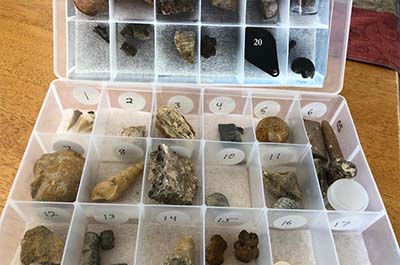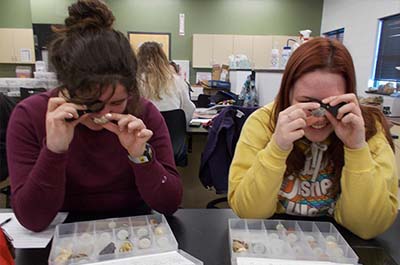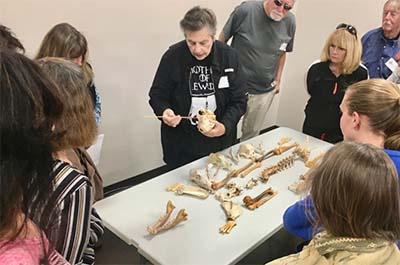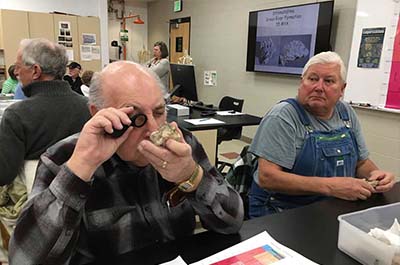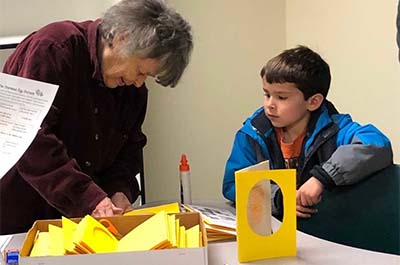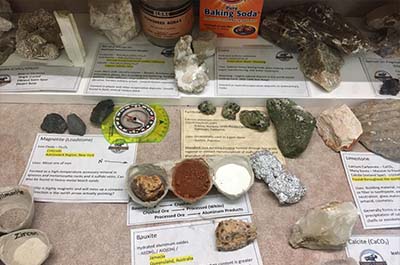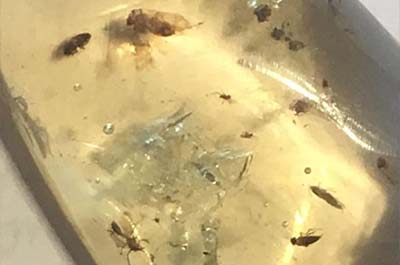Fossil Study Group
August 17, 2016 meeting
Today we were treated to an excellent Training Session on Corals by Loretta Bailey, who has been a long-time ammonite and baculite fossil collector on Spud Hill, north of Central & Orchard in Cañon City. The site was a former Tepee Butte before the hill was leveled by a land developer many years ago. (“Tepee Buttes are carbonate mounds formed around methane springs and vents on the seafloor of the Cretaceous Interior Seaway.” S. Veatch)
Loretta described the 3 types of corals: Rugosa, Tabulata and Scleractinia. She explained that they are relatives of today’s jellyfish. We studied the anatomical structure of corals, the environment they live in, coral reef formation, extinction periods and growth rings. Under magnification, daily coral growth lines are visible!
Devonian corals have 400 growth lines, rings or ridges/year; 35-40 more than current corals because days were shorter and years were longer 420 million years ago. We found this fascinating, and one of us will do more research.
Most fascinating was a fossil Loretta found on Spud Hill in 2005. Loretta keeps excellent records! It looks like a solitary rugose fossil, but those went extinct at the end of the Permian Period at 250 million years ago, and her fossil was found in the Upper Cretaceous Pierre Shale, a marine deposit from the Western Interior Seaway days, a much more recent deposit. So we have some research to do to determine exactly what Loretta found. More fun!
Loretta showed us her highly technical field gear: a paint can opener for prying up rocks, magnifying glass, clothespin and a couple of pencils.
One of our members shared an experience from several years ago when she was a diver along the Mexican coast, helping to set anchors for yachts. She swam too close to a coral reef and got a deep cut on her leg, which began to bleed profusely. She was helped to shore, where the local bartender came to her aid by pouring good whiskey on her cut. She spent several months fighting to live, as polyps (the soft-bodied organisms) from the coral had invaded her blood stream, took up residence and circulated throughout her body. It was her immune system and white blood cells versus the polyps, and much of the time the invaders seemed to be winning. Called serum poisoning, she suffered near-kidney and near-liver failure, and watched as large chunks of her flesh came off around the wound. She is with us today, having vanquished the polyps, but it was a long hard struggle, and today’s lesson on corals became all the more fascinating.
The parting words from the bartender:
Hate to waste good whisky on a gringa!
More information on Corals:
More Articles from “Stones ‘n’ Bones Activities”
Fossil Boot Camp – Covid Style
Stones ‘n Bones of Fremont County traditionally presents two or three Fossil Boot Camp classes each year for school age students and adults. With COVID, that has proven a little difficult
Fossil Boot Camp for PCC Historical Geology Students
Fremont Stones ‘n Bones introduced 16 Pueblo Community College students to fossils in Steve Wolfe’s Historical Geology class.
Stones ‘n’ Bones With Villa Bella School’s 2nd Graders
“What do paleontologists do?” is the question we were asked to help answer for 50 second graders at Pueblo, Colorado’s newest elementary school on January 16, 2020.
The Close Relationship Between Man & Dog
Dr. Sue Ware returned to the Royal Gorge Dinosaur Experience for the second time, to the delight of 27 community members. She presented a program entitled “From your Campfire to your Bed: The Evolution, Importance & Relationship between Dogs and Humans”.
Fossil Boot Camp at PCC Mini-College
For the 5th straight year, Stones ‘n Bones presented Fossil Boot Camp to 31 senior citizens in the Fremont County community.
Stones ‘n’ Bones & the Enormous Egg
What happens when an entire elementary school reads the same book, The Enormous Egg, and asks Fremont County Stones and Bones to come in to help with the family night to celebrate the reading? A two-hour evening full of paleontology learning!
Introducing Geology Students to Fossils
How does Steve Wolfe, Historical Geology instructor at PCC-Fremont Campus, prepare his students for field season observations? One way is by introducing them to fossils
Identifying Trilobites
The Pioche Formation of eastern Nevada is world famous for its amazing preservation of trilobites. Very old trilobites, from the Lower Cambrian (542 – 521 million years old), almost the oldest on record.
Everything Begins With Mining
There are many ways to appreciate rocks. Many of us notice them simply for their color, texture and shape, irresistible and raw in nature.
Insects Trapped in Amber
Many of us are familiar with the high preservation of insects and leaves in the Green River Formation, a Colorado lagerstätte well known for field trips yielding magnificent fossils.

